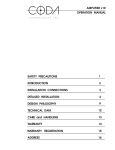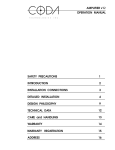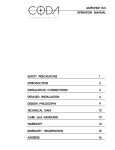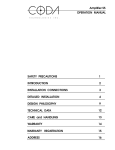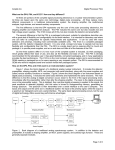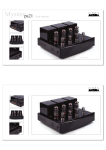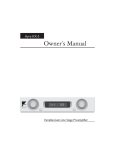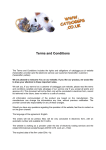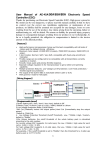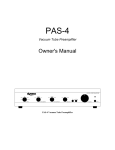Download Coda Technologies S12.5 Stereo Amp Manual
Transcript
Amplifier S12.5 OPERATION MANUAL T E C H N O L O G I E S I N C . XLR/GN BIAS PRECISION BIAS CLASS A AMPLIFIER S INPUT LEFT RIGHT RCA/YL 12.5 SAFETY PRECAUTIONS 1 INTRODUCTION 2 INITIAL SETUP 3 DETAILED INSTALLATION 4 DESIGN PHILOSOPHY 8 TECHNICAL DATA 11 CARE AND HANDLING 12 WARRANTY & DISCLAIMER 13 WARRANTY REGISTRATION 14 SAFETY PRECAUTIONS 1 CAUTION WARNING ! CAUTION: TO PREVENT ELECTRIC SHOCK, DO NOT REMOVE COVER. NO USER SERVICEABLE PARTS INSIDE, REFER SERVICING TO QUALIFIED SERVICE PERSONNEL. THIS SYMBOL IS TO ALERT YOU OF THE PRESENCE OF UNINSULATED DANGEROUS VOLTAGE WITHIN THE UNIT'S ENCLOSURE THAT MAY BE OF SUFFICIENT MAGNITUDE TO CONSTITUTE A RISK OF ELECTRIC SHOCK. ! THIS SYMBOL IS INTENDED TO ALERT YOU OF THE PRESENCE OF IMPORTANT OPERATING AND MAINTENANCE INSTRUCTIONS IN THE LITERATURE ACCOMPANYING THE UNIT. WARNING: TO PREVENT FIRE OR SHOCK HAZARD, DO NOT EXPOSE THIS UNIT TO RAIN OR MOISTURE. TO AVOID ELECTRICAL SHOCK, DO NOT OPEN THE UNIT. REFER SERVICING TO QUALIFIED PERSONNEL. CAUTION - Never install or remove the power cord from the chassis unless it has been disconnected from the AC power source first. Never pull on the power cord when removing it from an AC power source. Grasp it by the plug. Do not leave the power cord connected to an AC power source unless it is connected to the unit. It is recommended that during extended periods of nonuse the unit's power cord be unplugged from its AC power source. Route the AC power cord so that it will not be damaged or walked on. INTRODUCTION 2 Thank you for purchasing the AMPLIFIER S12.5. This amplifier is a precision device, designed in an effort to provide the listener with unmatched sound quality through superb design and construction. Although its operation is fairly simple, in order to operate your amplifier properly and to realize all of the capabilites of the S12.5 we recommend that you read this entire manual carefully. INITIAL SETUP 3 WARNING: Please ensure that the power switch is turned OFF while you are connecting the amplifier. Connecting or disconnecting cables while the amplifier is powered on could cause damage to your speakers. The diagram below shows the default connections necessary to operate the AMPLIFIER S5.5 as a stereo amplifier. This is the simplest and most common mode of operation, and the quickest way to get started. Note: Ensure that the MODE switch located between the input jacks on the rear of the amplifier is set to the STEREO position for normal operation. Bridged operation is explained on page 7. Stereo Amplifier Configuration PREAMPLIFIER ! ~ AC LINE INPUT SEE SERIAL T AG FOR POWER REQUIREMENTS FOR CONTINUED PROTECTION AGAINST SHOCK OR FIRE HAZARD,DO NOT EXPOSE THIS UNIT TO RAIN OR MOISTURE. VIDEO UNBALANCED OUTPUT LEFT RIGHT LEFT PROCESSOR LEFT IN RIGHT LEFT RIGHT LEFT CHANNEL OUT MONITOR IN RIGHT LEFT RIGHT OUT LEFT INPUTS VIDEO INPUTS UNBALANCED LEFT RIGHT TUNER RIGHT LEFT RIGHT COMPACT DISC LEFT RIGHT UNBALANCED INPUT LEFT RIGHT RIGHT CHANNEL UNBALANCED PUSH PUSH BALANCED BALANCED MODE STEREO BRIDGED FOR CONTINUED PROTECTION CAUTION AGAINST SHOCK OR FIRE: MODEL 1. REPLACE FUSE WITH SAME SERIAL NUMBER TYPE AND RATING VOLTAGE REQUIREMENT HZ POWER REQUIREMENT VA 2. DO NOT EXPOSE THIS UNIT T E C H N O L O G I E S I N C . ! AC LINE FUSE CHART VOLTAGE 100V WARNING MANUFACTURED IN THE USA TO RAIN OR MOISTURE ~ AC LINE INPUT NOTE MAIN POWER FUSE AND VOLTAGE SELECTOR FUSE TYPE ! TO PREVENT ELECTRIC SHOCK, DO NOT REMOVE COVER. NO USER SERVICEABLE PARTS INSIDE. REFER SERVICING TO QUALIFIED SERVICE PERSONNEL. ! DO NOT ALLOW AMPLIFIER OUTPUTS TO COMMON BETWEEN CHANNELS, 12 AMP SLOW BLOW 5 x 20mm OR CONTACT CHASSIS OR INPUT 120V 12 0 GROUNDS, OR TO BE CONNECTED 220V TO ANY ACTIVE CURRENT SOURCE. 6 AMP SLOW BLOW 5 x 20mm 240V SEE SERIAL TAG FOR POWER REQUIREMENTS, REMOVE POWER CORD BEFORE CHANGING FUSE OR LINE VOLTAGE LEFT SPEAKER FUSE VALUE -SEE FUSE CHART VOLTAGE SELECTIONSEE OPERATION MANUAL OFF ON AMPLIFIER S12.5 RIGHT SPEAKER DETAILED INSTALLATION 4 I. Connections The connectors and controls are clearly marked on the back panel of the AMPLIFIER. Note the correct left or right channel orientation. The function and channel markings on the rear panel correspond to the front panel controls and their signal paths. 1.The UNBALANCED and BALANCED inputs should be attached to the appropriate unbalanced and balanced outputs of a preamplfier either directly or through a crossover or processor, as appropriate to the application. 2.The LEFT OUTPUT and RIGHT OUTPUT should be attached to the left and right speakers. WARNING: There are no fuses on the amplifier’s outputs in order to cut down on output impedance effects. Speaker protection is left to the manufacturer of your speakers, as they would best know how to protect their product. 3.The AC LINE INPUT should be connected to an AC outlet with the power cable provided with the amplifier. 4.The FUSE AND VOLTAGE SELECTOR unit houses a 5x20mm slow-blow fuse and a voltage selector cartridge. Ensure that the voltage, visible through a small window next to the AC input, is set to the appropriate voltage for your country. When changing voltages, ensure that the power cable is disconnected from the amplifier. Note: If the fuse in your amplifier blows, contact a Coda dealer or call Coda directly before attempting to use the amplifier again. 3.The POWER SWITCH can usually be left on when the amplifier is functioning correctly. With the bias disabled the amplifier will draw negligible current and can thus be left in “standby” indefinitely. 2 1 LEFT CHANNEL 2 INPUTS RIGHT CHANNEL INPUTS UNBALANCED UNBALANCED PUSH PUSH BALANCED BALANCED MODE STEREO BRIDGED FOR CONTINUED PROTECTION CAUTION AGAINST SHOCK OR FIRE: MODEL 1. REPLACE FUSE WITH SAME SERIAL NUMBER TYPE AND RATING VOLTAGE REQUIREMENT HZ POWER REQUIREMENT VA 2. DO NOT EXPOSE THIS UNIT T E C H N O L O G I E S I N C . MANUFACTURED IN THE USA TO RAIN OR MOISTURE ! AC LINE FUSE CHART VOLTAGE 100V WARNING ~ AC LINE INPUT NOTE MAIN POWER FUSE AND VOLTAGE SELECTOR FUSE TYPE ! TO PREVENT ELECTRIC SHOCK, DO NOT REMOVE COVER. NO USER SERVICEABLE PARTS INSIDE. REFER SERVICING TO QUALIFIED SERVICE PERSONNEL. ! DO NOT ALLOW AMPLIFIER OUTPUTS TO COMMON BETWEEN CHANNELS, 12 AMP SLOW BLOW 5 x 20mm 6 AMP SLOW BLOW 5 x 20mm OR CONTACT CHASSIS OR INPUT 120V 12 0 GROUNDS, OR TO BE CONNECTED 220V TO ANY ACTIVE CURRENT SOURCE. 240V SEE SERIAL TAG FOR POWER REQUIREMENTS, REMOVE POWER CORD BEFORE CHANGING FUSE OR LINE VOLTAGE 3 FUSE VALUE -SEE FUSE CHART VOLTAGE SELECTIONSEE OPERATION MANUAL 4 OFF ON 5 DETAILED INSTALLATION 5 II. Front Panel Control Functions and Indicators 1. The BIAS button enables the bias, effectively "turning on" the amplifier's components, and opens shunting relays that mute the input. 2. The INPUT SELECTOR button switches between the balanced and unbalanced inputs. 3. These LEDs, when lit, indicate that the bias is enabled and muting is off. 4. This two color LED indicates that the main power is on. When it is red the balanced inputs are in use. When it is yellow the unbalanced inputs are in use. XLR/GN BIAS PRECISION BIAS CLASS A AMPLIFIER S INPUT RIGHT LEFT RCA/YL 12.5 1 2 3 4 Note: If a power interruption occurs to the system the amplifier will power on with the bias off. Press the BIAS button to resume use of the amplifier. DETAILED INSTALLATION 6 III. BRIDGED SETUP WARNING: Disconnect the amplifier's power cord from the AC supply and set the power switch to OFF before adjusting the mode switch or connecting or disconnecting any cables to avoid potential damage to your speakers. The S12.5 normally operates in stereo mode, providing a maximum output power of 50 watts Class A (into an 8-ohm load) per channel. In BRIDGED mode, both channels act as one amplifier providing a maximum output power of 200 watts. For extremely high-power multi-channel audio applications, multiple S12.5 amplifiers can be used in place of one medium-power stereo amp. To configure the amplifier for bridged mode operation, set the mode switch on the back panel to the BRIDGED setting as shown in the diagram below. Back of AMPLIFIER S12.5 PUSH PUSH MODE STEREO BRIDGED MODEL SERIAL NUMBER In bridged mode only one audio input is used. No other input should be connected, and the bridged mode input must be a BALANCED signal connected to the XLR receptacle labeled BRIDGED INPUT. Bridged mode will not operate correctly with an input adapted from an unbalanced signal. Connecting the input signal to the receptacle not labeled BRIDGED INPUT will cause no damage, but will cause the speaker terminal polarities to reverse, so should be avoided in the interest of consistency in labeling. The amplifier’s speaker terminals are reconfigured in bridged mode. The left channel positive terminal becomes the bridged negative terminal and the right channel positive terminal becomes the bridged positive terminal. See the next page for a diagram of a stereo amplifier configuration using two bridged mode S12.5 amplifiers. Speaker terminals in the diagram are marked with their bridged mode polarities. Technical Note: In bridged mode the XLR input receptacles are internally connected to each other according to the diagram below. Bridged Mode XLR Wiring PUSH 1 PUSH 2 3 1 2 3 7 DETAILED INSTALLATION IV. BRIDGED SETUP DIAGRAM LEFT SPEAKER Bridged Output LEFT CHANNEL INPUTS I UNBALANCED G BALANCED O E S I N C PUSH . STEREO MODE BRIDGED PUSH FUSE AND VOLTAGE SELECTOR 12 0 FUSE VALUE -SEE FUSE CHART VOLTAGE SELECTIONSEE OPERATION MANUAL OFF MANUFACTURED IN THE USA INPUTS BALANCED UNBALANCED CAUTION WARNING ! ! TO ANY ACTIVE CURRENT SOURCE. GROUNDS, OR TO BE CONNECTED OR CONTACT CHASSIS OR INPUT TO COMMON BETWEEN CHANNELS, DO NOT ALLOW AMPLIFIER OUTPUTS NOTE TO PREVENT ELECTRIC SHOCK, DO NOT REMOVE COVER. NO USER SERVICEABLE PARTS INSIDE. REFER SERVICING TO QUALIFIED SERVICE PERSONNEL. RIGHT CHANNEL MODEL FOR CONTINUED PROTECTION L AGAINST SHOCK OR FIRE: O HZ N VOLTAGE REQUIREMENT H SERIAL NUMBER C 1. REPLACE FUSE WITH SAME E MAIN POWER TYPE AND RATING T AC LINE INPUT SEE SERIAL TAG FOR POWER REQUIREMENTS, REMOVE POWER CORD BEFORE CHANGING FUSE OR LINE VOLTAGE ~ VA FUSE TYPE SLOW BLOW 5 x 20mm SLOW BLOW 5 x 20mm ON POWER REQUIREMENT 2. DO NOT EXPOSE THIS UNIT 6 AMP 12 AMP AC LINE FUSE CHART TO RAIN OR MOISTURE ! VOLTAGE 120V 100V 220V 240V Bridged Output ! ~ AC LINE INPUT SEE SERIAL T AG FOR POWER REQUIREMENTS FOR CONTINUED PROTECTION AGAINST SHOCK OR FIRE HAZARD,DO NOT EXPOSE THIS UNIT TO RAIN OR MOISTURE. UNBALANCED OUTPUT LEFT RIGHT LEFT VIDEO RIGHT LEFT IN RIGHT PROCESSOR LEFT OUT RIGHT LEFT IN RIGHT LEFT OUT RIGHT LEFT VIDEO RIGHT LEFT CHANNEL LEFT E S TUNER INPUTS G I UNBALANCED O BALANCED L I C RIGHT N PUSH . COMPACT DISC LEFT RIGHT STEREO MODE BRIDGED PUSH FUSE AND VOLTAGE SELECTOR 12 0 FUSE VALUE -SEE FUSE CHART VOLTAGE SELECTIONSEE OPERATION MANUAL OFF MANUFACTURED IN THE USA CAUTION WARNING ! ! TO ANY ACTIVE CURRENT SOURCE. GROUNDS, OR TO BE CONNECTED OR CONTACT CHASSIS OR INPUT TO COMMON BETWEEN CHANNELS, DO NOT ALLOW AMPLIFIER OUTPUTS NOTE TO PREVENT ELECTRIC SHOCK, DO NOT REMOVE COVER. NO USER SERVICEABLE PARTS INSIDE. REFER SERVICING TO QUALIFIED SERVICE PERSONNEL. RIGHT CHANNEL UNBALANCED INPUT LEFT RIGHT INPUTS BALANCED UNBALANCED MODEL O AGAINST SHOCK OR FIRE: FOR CONTINUED PROTECTION MONITOR PREAMPLIFIER Bridged Output N HZ H VOLTAGE REQUIREMENT C SERIAL NUMBER E MAIN POWER 1. REPLACE FUSE WITH SAME T AC LINE INPUT TYPE AND RATING SLOW BLOW 5 x 20mm SEE SERIAL TAG FOR POWER REQUIREMENTS, REMOVE POWER CORD BEFORE CHANGING FUSE OR LINE VOLTAGE ~ VA 12 AMP SLOW BLOW 5 x 20mm ON POWER REQUIREMENT 2. DO NOT EXPOSE THIS UNIT 6 AMP FUSE TYPE AC LINE FUSE CHART TO RAIN OR MOISTURE ! VOLTAGE 120V 100V 220V 240V Bridged Output RIGHT SPEAKER DESIGN PHILOSOPHY 8 I. Design Philosophy and Approach The subtlety of the design process at this level of performance makes it impossible to easily explain all of the advantages inherent in the S12.5. However, we present here an overview to give you an understanding of some of its unique features and an idea of the listening experience you can expect. Often a particular technique has numerous unrelated advantages and possibilities. We make every effort to exploit these advantages with the final result being an amplifier that is greater than the sum of its individual features The topology and component selection is built on the foundation established by the System 100. Balanced interconnections are provided to take advantage of their greater noise rejection as in the System 100. Differential voltage gain throughout provides exceptional rejection of external noise and contributes to the inherent DC stability of the circuit. This allows direct coupling without servo circuitry. The unit also uses output followers operating without feedback. The front end of the S12.5 is designed to operate without ever entering Class B operation as is common in many other designs. This combined with excellent high frequency design insures linear operation at high speed, and translates into a sonic reproduction which is extremely transparent in character. The supplie take a very direct approach to high performance. First, a top quality toroid transformer and over 144,000 uf of capacitance with very low ESR and inductance is used. For optimum performance and reliability all circuity remains continuosly powered. The specifications are consistent with what would be expected in a high current Class A amplifier design. In this design , however , an unusual degree of attention has been paid to sonically meaningful parameters. For example, the current stage is capable of producing peak currents in excess of 100 Amperes with a degree of linearity and speed which is not matched by other designs when producing only a fraction of of this current. This is achieved by the implementation of several distinct circuit features. In the S12.5 extremely wide bandwidth output transistors are used instead of the usual TO3 devices which are used in other transistor designs. Each channel uses 30 individual output transistors with a combined power rating of 1500 Watts and 120 Amperes with a bandwidth of 50 Mhz. The manner in which the S12.5 accomplishes Class A operation is also different than that employed in conventional designs. All Class A designs leave Class A operation when they are operated into loads of sufficiently low impedance or power levels. Generally, this transition will produce a large and abrupt distortion increase. The S12.5 uses bias voltages and component values which have been specifically selected to produce a precision transition with no abrupt changes in distortion or output impedance. This“Precision Bias” technique yields seemless performance regardless of the complexity of the load impedance and is particularly effective at eliminating a form of IM distortion which often occurs in these instances. DESIGN PHILOSOPHY 9 I. Design Philosophy and Approach (continued) To maintain “Precision Bias” requires an advanced bias circuit that must have a very high degree of stability under a wide range of temperatures and load conditions. The usual bias network is of such high impedance and poor thermal regulation that at the extremes of operation, bias currents are ineffectively controlled. Advanced tracking techniques results in absolute control of bias currents under all conditions in the S12.5. The main power supply of the amplifier consists of a 1500VA toroidal power transformer with independent rectifiers to isolate the channels from one another. One hundred fourty-four thousand microfarads of total capacitance provide effective filtering. The above attributes result in a amplifier of such extreme linearity and bandwidth that no overall feedback correction is required or used. One advantage of this is a high degree of immunity from interactions with loads or cables and a superior transient response. An extremely low nonreactive output impedance is maintained well beyond 20,000 hz. The resulting uniform damping factor is not usually found in other designs. The S12.5 has all structural parts made of machined aluminum which are milled to very close tolerances yielding the seamless appearance characteristic of previous products from Coda. As with all Class A amplifiers, heat dissipation is important. The S12.5 uses four massive heat sinks for efficient, noiseless, and clean thermal relief. The thermal coefficient of the heat sinks is one of the lowest and most effective in the audio industry. DESIGN PHILOSOPHY 10 II. Material Quality The amplifier’s chassis is made from heavy-gauge steel with a half-inch machined aluminum faceplate. All exterior metal parts are anodized or powder coated for durability. Printed circuit boards are fiberglass epoxy with gold plating over a tin/nickel barrier. The gold layer will not corrode, while the barrier layer prevents the gold from migrating to the lower copper layer. All resistors are precision metal film; 1% tolerance for 1/4-watt and 5% tolerance for 1-watt. Capacitors have been eliminated wherever possible. No electrolytic capacitors are used except in the power supply, where several high-capacitance electrolytics provide outstanding filtering of the supply output. All semiconductor devices are of very high grade. Voltage gain is accomplished with an extremely high-quality, matched dual FET, chosen for it’s exceptionally low noise characteristics. All audio input and output connector contacts are gold-plated, and XLR receptacles are manufactured by Neutrik of Switzerland. Wire is used as little as possible in the signal path - only to connect the RCA jacks and speaker terminals to the circuit board - and what is used is 141-strand silver-plated copper with silicone insulation. 11 TECHNICAL DATA STEREO Rated Power: Frequency Response: Distortion: Gain: Maximum Current: Noise: input Impedance: Output Impedance: 125 Watts @ 8 Ohms DC to -3dB @ 100kHz < .03 percent from 10Hz to 20kHz @ 125 Watts 26dB >100 Amperes peak per channel -120dB referenced to rated output 50k Ohms unbalanced/1k Ohms balanced .03 Ohms from 20Hz to 20kHz BRIDGED MONO Rated Power: Frequency Response: Distortion: Gain: Maximum Current: Noise: Input Impedance: Output Impedance: 500 Watts @ 8 Ohms DC to -3dB @ 100kHz < .03 percent from 10 Hz to 20kHz @ 400 Watts 32dB >100 Amperes peak -120dB referenced to rated output 1k Ohms unbalanced/1k Ohms balanced .06 Ohms from 20Hz to 20kHz CLASS A/AB OPERATION Class A: Class AB: < 20W >20W POWER SUPPLY Transformer Type: Transformer Rating: Power Filtering: Multi-tap, multi-winding toroidal 1500 VA 144,000 µF DIMENSIONS Height: Width: Depth: Weight: Power requirement: 5.25" Faceplate, 6.0" Overall 19.0" Faceplate, 17.0" Chassis 12.5" Overall 45 lbs., 50 lbs., Shipping 450 Watts maximum at rated power CARE AND HANDLING 12 The interior of the amplifier requires no special care. If exterior cleaning beyond simple dusting is required, any dilute ammonia-based product is recommended. Do not use any abrasive rags, cleaners or chemical solvents on the amplifier. When handling the amplifier, take care not to mar the faceplate. Aluminum is a medium hardness metal and can be scratched by harder tool steels, and the grained surface can be easily marred if the amplifier is set face-down on a hard surface. Do not rest the amplifier on it’s faceplate. The amplifier should not be left in direct sunlight or exposed to intense heat to avoid damage to internal components or finish. It is recommended that you do not throw away any shipping material. The box and packing materials are ideal for moving, and if any service is required they will be necessary for safe shipment. WARRANTY & DISCLAIMER 13 i. Warranty - Any failure of the Amplifier S12.5, hereafter known as the product or original product, to operate or to meet specifications, applicable at time of manufacture, due to a manufacturing defect or component failure, will be corrected by Coda Technologies without charge for parts or labor, for a period of ten years from date of original purchase. Coda Technologies will provide for surface transportation to and from the factory for a period of one year from date of original purchase. ii. Procedure - If the product should require service under warranty contact Coda Technologies at the location on the back cover of this manual for shipping instructions. Products purchased outside of the United States will be covered by the warranty conditions extended by the importing distributor which may differ from those given above. iii. Exclusion of Coverage - Coda Technologies is not obligated to service the product in certain conditions, as according to the following subsections. a. The product has been damaged through: i. operation not in accordance with the instructions in this manual ii. abuse, tampering, modification or accident iii. serial number defacement b. The product has been transferred to a third party. This warranty is valid only for the original purchaser of the product. c. The product has been transported outside of the United States of America. In these conditions any service will be made at Coda Technologies sole option. iv. Total Loss and Replacement - If the product is submitted for service due to a severe malfunction which has caused damage sufficient enough to make a repair attempt infeasible, the product will be replaced with another unit of equal or superior specifications. Coda Technologies product line is frequently updated and changed, and the specific model and version of the original product may be discontinued at any time without notice. In this case no guarantees are made that the replacement unit will be visually similar to the original product. v. Subjective Differences - No guarantee is made that the product will perform to any specifications that cannot be measured and confimed with precision audio analysis equipment. Coda Technologies is only obligated to make repairs which will bring the product into compliance with the specifications stated in this manual. vi. Unnecessary Service - In all conditions, if the product is submitted for service and found to be operated without fault and within specifications, shipping charges will be billed to the customer. This warranty gives you specific legal rights. You may have other rights which vary from state to state. Disclaimer - Coda Technologies cannot be held responsible for any damage caused by their products, including but not limited to: a. Damage to speakers caused by failure of a Coda Technologies product to mute or disable itself as expected or described in its manual. b. Damage caused by connecting a load to a Coda Technologies product having an improper impedance as described in the products manual. d. Damage caused by defects in design, construction or component quality. WARRANTY REGISTRATION 14 Fill in this registration sheet and fax or mail it to Coda Technologies to ensure you are in our warranty system. This will facilitate warranty service should it become necessary. It is recommended that you retain a copy of this form for your own records. Coda Technologies’ address and fax number are located on the back of this manual. MODEL DESIGNATION: __________________________________ SERIAL NUMBER: ______________________________________ DATE OF PURCHASE: PLACE OF PURCHASE Dealer: Address: City: State: Zip: State: Zip: Phone: PURCHASER Name: Address: City: Phone: NOTES: 7850 CUCAMONGA AVENUE #31 SACRAMENTO, CA 95826 USA T E C H N O L O G I E S I N C . phone +01 916.383.3653 fax +01 916.455.3653 on the web at CODA.CC email us at [email protected]

















